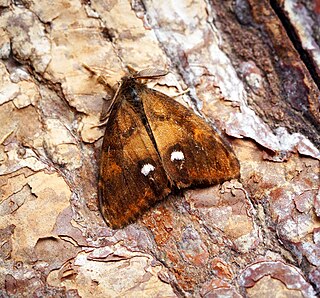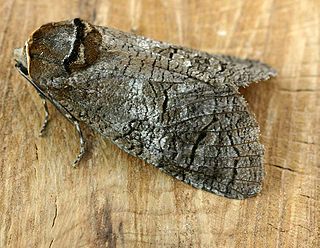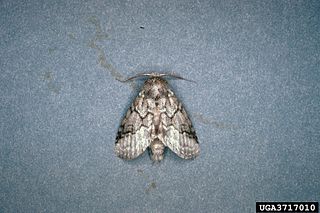
The geometer moths are moths belonging to the family Geometridae of the insect order Lepidoptera, the moths and butterflies. Their scientific name derives from the Ancient Greek geo γεω, and metron μέτρον "measure" in reference to the way their larvae, or inchworms, appear to measure the earth as they move along in a looping fashion. Geometridae is a very large family, containing around 23,000 described species; over 1400 species from six subfamilies are indigenous to North America alone. A well-known member is the peppered moth, Biston betularia, which has been the subject of numerous studies in population genetics. Several other geometer moths are notorious pests.

The flannel moths or crinkled flannel moths are a family of insects. They occur in North America and the New World tropics.

The winter moth is a moth of the family Geometridae. It is an abundant species in Europe and the Near East and a famous study organism for evaluating insect population dynamics. It is one of very few lepidopterans of temperate regions in which adults are active in late autumn and early winter. The adults use endothermy for movement in these cold temperatures. The females of this species are virtually wingless and cannot fly, but the males are fully winged and fly strongly. After the initial frosts of late fall, the females emerge from their pupae, walk to and up trees and emit pheromones in the evening to attract males. After fertilization, they ascend to lay, on average, around 100 eggs each. Typically, the larger the female moth is, the more eggs she lays.

The eastern tent caterpillar is a species of moth in the family Lasiocampidae, the tent caterpillars or lappet moths. It is univoltine, producing one generation per year. It is a tent caterpillar, a social species that forms communal nests in the branches of trees. It is sometimes confused with the spongy moth and the fall webworm, and may be erroneously referred to as a bagworm, which is the common name applied to unrelated caterpillars in the family Psychidae. The moths oviposit almost exclusively on trees in the plant family Rosaceae, particularly cherry (Prunus) and apple (Malus). The caterpillars are hairy with areas of blue, white, black and orange. The blue and white colors are structural colors created by the selective filtering of light by microtubules that arise on the cuticle.

Notodontidae is a family of moths with approximately 3,800 known species. The family was described by James Francis Stephens in 1829. Moths of this family are found in all parts of the world, but they are most concentrated in tropical areas, especially in the New World.

The buff-tip is a moth of the family Notodontidae. It is found throughout Europe and in Asia to eastern Siberia. The species was first described by Carl Linnaeus in his 1758 10th edition of Systema Naturae.

The Lasiocampidae are a family of moths also known as eggars, tent caterpillars, snout moths, or lappet moths. Over 2,000 species occur worldwide, and probably not all have been named or studied. It is the sole family in superfamily Lasiocampoidea.

Tent caterpillars are moderately sized caterpillars, or moth larvae, belonging to the genus Malacosoma in the family Lasiocampidae. Twenty-six species have been described, six of which occur in North America and the rest in Eurasia. Some species are considered to have subspecies as well. They are often considered pests for their habit of defoliating trees. They are among the most social of all caterpillars and exhibit many noteworthy behaviors.

Orgyia antiqua, the rusty tussock moth or vapourer, is a moth in the family Erebidae.

Halysidota tessellaris, also called the pale tiger moth, banded tussock moth, and tessellated halisidota, is in the family Erebidae and the tribe Arctiini, the tiger moths. The species was first described by James Edward Smith in 1797. Like many related species, adult moths have chemical defenses acquired from its host plants, in this case, alkaloids. Larval behaviors suggest that they are chemically protected; they have not been analyzed for alkaloid content.

Orgyia leucostigma, the white-marked tussock moth, is a moth in the family Erebidae. The species was first described by James Edward Smith in 1797. The caterpillar is very common especially in late summer in eastern North America, extending as far west as Texas, California, and Alberta.

The bird-cherry ermine is a species of moth in the family Yponomeutidae, the ermine moths. The wingspan of the moth ranges from 16 to 25 mm. The insect was first described in 1758 by the Swedish naturalist Carl Linnaeus who gave it the name Phalaena evonymella; it was later transferred to the genus Yponomeuta, becoming Yponomeuta evonymella. The moth can be found in the whole of Europe and the northern and eastern part of Asia.

Callosamia promethea, commonly known as the promethea silkmoth, is a member of the family Saturniidae, which contains approximately 1,300 species. It is also known as the spicebush silkmoth, which refers to is one of the promethea silkmoth's common host plants, spicebush. C. promethea is classified as a silk moth, which stems from its ability to produce silk, which it does in the formation of its cocoon. C. promethea lives in forests in the eastern U.S. and does not damage the trees on which it lives. The species was first described by Dru Drury in 1773.

Glochidion ferdinandi, with common names that include cheese tree, is a species of small to medium–sized trees, constituting part of the plant family Phyllanthaceae. They grow naturally across eastern Australia, from south–eastern New South Wales northwards to northern and inland Queensland, in rainforests and humid eucalypt forests. Frugivorous birds such as pigeons, figbirds and parrots consume its fruit. The tree roots and branches are toxic to dogs, causing liver failure and death.

Cossus cossus, the goat moth, is a moth of the family Cossidae. It is found in Northern Africa, Asia and Europe.

Calliteara pudibunda, the pale tussock, is a moth of the family Erebidae. The Dutch common name for the moth (Meriansborstel) comes from the butterfly and insect painter Maria Sibylla Merian. The species was first described by Carl Linnaeus in his 1758 10th edition of Systema Naturae. It is found in Asia and Europe.

Lochmaeus is a genus of moths of the family Notodontidae first described by Edward Doubleday in 1841.

Lochmaeus bilineata, the double-lined prominent moth, is a moth of the family Notodontidae. It is found in the eastern two-thirds of the United States and southern Canada, west to New Mexico in the south and Saskatchewan in the north.

Lymantria dispar dispar, commonly known as the gypsy moth, European gypsy moth, LDD moth, or North American gypsy moth or spongy moth, is a species of moth in the family Erebidae. It has a native range that extends over Europe and parts of Africa, and is an invasive species in North America.

Odonestis pruni, also known as the plum lappet moth or the plum eggar, is a species of moth, belonging to the family Lasiocampidae. It was first described by Carl Linnaeus in 1758. It is native to Eurasia.



















